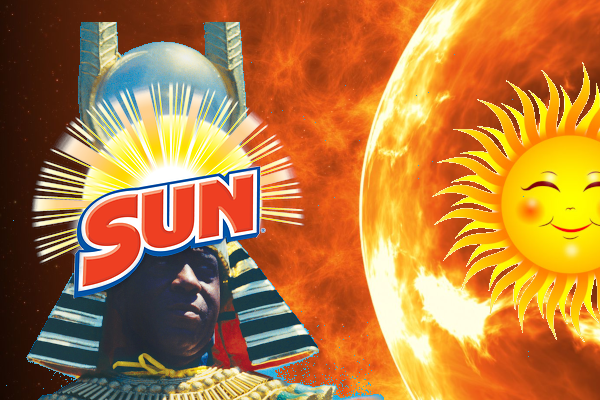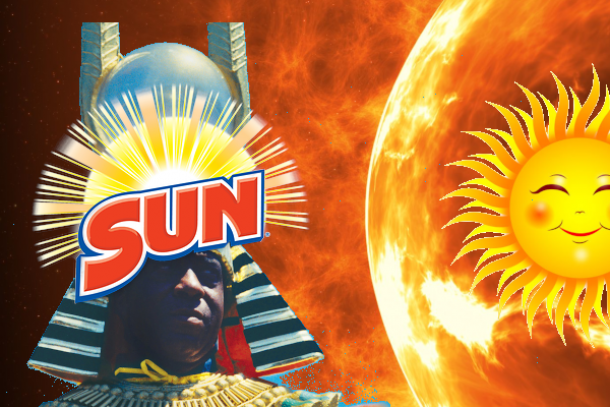**S*__*U*__*N**
How to Determine Direction Using the Sun
Download Article
METHODS
1Using the Sun
2Using Shadows Cast by the Sun
Knowing the direction you are traveling can be the difference between life and death when lost in the wilderness. Beyond survival situations, knowing the direction you are heading can help when lost on the road, or even when passing through an unfamiliar area. Since ancient times travelers have used the sun to determine direction, and with a little know-how, you can figure out direction with a glance at the sun, too.[1]
Method
1
Using the Sun
Image titled Determine Direction Using the Sun Step 1
1
d more like bright clouds of light because of the gaseous state of the star. In reality, the Sun isn’t really yellow, orange, or red. It’s technically all colors and light mixed together. In space, the human eye perceives this as totally white. This also explains the existence of rainbows, which are visible when sunlight is separated into its actual colors.
Conclusion
Without a doubt, the Sun is one of the most interesting things in our solar system. Without it, the Earth and all the planets around us would likely be wildly different- if they were able to exist at all. Not only is the Sun necessary in this practical matter, but it also governs most aspects of human life. Consider all of the plants we eat, that are able to grow thanks to photosynthesis and the light of the Sun.
Not to mention, the circadian rhythms of our waking up and going to sleep- largely based on the sunrises and sunsets that we witness here on Earth. And, most of the world abide by some sort of solar calendar. Many of our seasons and dates are based on the position of the Sun in the sky.
The discovery that the solar system revolved around the Sun is seen by many as the launching point of modern astronomy, and it’s definitely one of the most important discoveries ever to be made. At the time of his death in 1543, Copernicus even used his last words to explain his belief that the Sun was the center of the solar system. His last words were said to be “In the center of all rests the Sun. For who would place this lamp of a
On the first day of spring and the first day of f
Understand the motion of the sun in the sky. Due to the position of the earth and its motion through space, the sun generally moves through the sky from the east to the west. This is not a precise way of figuring out direction; depending on the time
, and silicon.
Interestingly enough, the reason for the Sun’s Population I classification is because older stars exploded, creating supernovae. The Sun actually contains all of these elements from a handful of previous stars. Many children believe that the Sun is a planet before they learn otherwise, and this is actually far from the truth. The Sun is wildly different from a planet, especially a rocky planet like Earth. It would be absolutely impossible to step foot onto the surface of the Sun- it’s all gas.
9The Sun Is Not That BigThe Sun Is Not That Big. It has a relative size in nature.
The Sun is really massive in some ways but really tiny in other ways. Size is relative in most contexts, but this is an especially important consideration when discussing astronomy. The Earth is tiny in the using an end to life on Earth. However, this isn’t going to happen for quite some time, so we don’t have to worry just yet.Essentially, since stars are balls of gas, they die once the gas runs out. The gas powers intense nuclear fusCommunity Answer
Point 2 is always your second point, no matter where e southeast part of the sky. Throughout the day, it will travel through the southeastern sky until it sets behind the southwestern horizon.[5]
NOTE: In the southe middle of its lifespan.Scientists and astronomers believe that there may be around a trillion stars similar to the Sun in the Milky Way, our galaxy. Another classification that the Sun falls unde
rn hemisphere (the southern parts of Africa, much of South America, Australia), the motion of shadows is reversed. This means that in summer the sun will rise in the southeast and in winter in the northeast, while spring and fall will be the same as the northern hemisphere with the sun rising in the east.[6]
Image titled Determine Direction Using the Sun Step 3
3
Find east using the sun. Now that you're equipped with knowledge about the sun's path through the sky, you should be able to determine the approximate direction of east. For example, in spring east will be roughly where the sun has risen. Face this direction.
of year, the exact path of the sun changes between the northeast-northwest, east-west, and southeast-southwest horizons of the sky.[2]
A significant excthe sun will move through the northeastern sky into the northwestern half, finally setting behind the northwestern horizon.
In spring and fall the sun will travel a more direct route through the sky. This means that it will rise in the east and pass through the sky to set in the west.
In winter the sun will rise in th
5
Nowadays, the fact the Earth revolved around the Sun is common scientific knowledge. Before the findings of Galileo and Copernicus in the 1500s, most people believed that the rest of the solar system actually revolved around the Earth. Although Nicolaus Copernicus made his theory in 1543, it took years and years for this to be accepted by the masses.
However, other scientists and astronomers had made s
r is Population I. This means a star that is mostly made up of heavier elements. In the case of our Sun, it’s made of about 70% hydrogen. Stars are balls of hot gas, and the rest of the Sun is made of helium and small amounts of carbon, nitrogen, oxygen, neon, iron, sulfur, magnesium
To find true-east more accurately in summer and winter, you'll have to adjust your direction slightly. In the summer you should adjust a little to the right, and in winter a little to the left.
The closer you are to the middle of the season, the more the sun will be oriented to the north in the summer or south in the winter. This means in the middle of summer and winter you'll have to adjust more to the right and left, respectively.
Image titled Determine Direction Using the Sun Step 4
4
Find west. The cardinal directions, north, south, east, and west, are equally distributed into quadrants on a compass. This means that east and west are directly opposite of each other, as are north and south. Since you're facing east, you now know the direction straight behind you is west.[7] [8]
You may find it easy to hold these direc
eimilar theories in the years past. An Indian philosopher, Yajnavalkya, recorded such a heliocentric theory as far back as the 9th Century BCE. Greek philosophers Aristarchus and Archimedes both made mention of similar theories in 310 BC or earlier. Throughout the years, the Sun has been much more than just a star in the sky. The Sun has been an object of worship, and an object of fear, and the source of all life on Earth. While it is technically a ball of hydrogen, plasma, and helium- it’s definitely much more than that. The Sun is an interesting part of life on Earth, even though it is millions of miles away from the planet.
Much of the scientific knowledge now accepted about the Sun has been discovered relatively recently, including some incredible and unbelievable facts. In the end, the Sun is the crowning jewel of our solar system, and the one thing holding all of the planets, stars, and asteroids around Earth in one cohesive system. It’s not just essential for us humans here on this planet, but also for the rest of the planets in the solar system.
10The Sun Is a Star
The Sun Is a Star and it contains all of these elements from a handful of previous stars.
The Sun is quite unique to us down here on Earth, but the truth is that it is technically just another star- of which there are billions and trillions in the universe. The Sun is classified as a Yellow Dwarf star or G2V. This classification includes stars that are between 5,300 and 6,000 K on their surface. This is how the surface temperature of stars is measured. This kind of star also has well-documented stages and life cycles. The sun is considered to be in th
tion in your mind using landmarks or a mental picture. However, if you struggle visualizing these directions, you may want to draw a line on the ground straight in front of you. The far end will point east and the near end will point west.eption to this general rule can be found at the north and south poles. The extreme position of each pole on planet earth creates long seasons of darkness and light, with the sun being absent in some places for up to six months![3]
Image titled Determine Direction Using the Sun Step 2
2
Know the season. Our planet not only travels through space, spinning on its axis from west to east, but it also tilts toward and away from the sun.[4] This tilt creates a difference in temperature that results in seasonal changes. The tilt of the earth will also influence the general position of the sun, so by knowing the season, you'll have a more accurate idea of the direction indicated by the movement of the sun in the sky.
In summer the sun rises over the northeast horizon. As the day passes,
Image titled Determine Direction Using the Sun Step 5or when it is marked. Point 1 is your first point. Try an experiment. Go outside your home or in a park Set a stick in the ground as shown above around 10:00 AM. Put a small rock at the shadow tip every 15-20 minutes until 2:00 PM. These rocks will describe a line. It will show as a “U” in the winter, an upside down “U” in the summer, or a straight line at the equinoxes.
Not Helpful 0Helpful 0
Question
If the first point is growing in a westerly direction, why continue with the other steps when I know where west is?
Community Answer
Community Answer
The first step is a one-off. It is only good at first light of the day. The second and subsequent steps are necessary for finding direction at any other time during daylight.
Not Helpful 2Helpful 0
Unanswered Questions
How do I find each direction when using the sun?ion in the core of a star, keeping it burning and lit up for millions of years. When the Sun runs out of hydrogen to power it, it will finally reach the end of its life cycle. When this happens, the Sun will not simply cease to exist. Rather, it will begin a transformation into a red giant star.
First, the core of the Sun will collapse when the hydrogen runs out. Then, the core will begin to burn up the hydrogen of the Sun itself and begin to swell and become much bigger. Thus, the death of the Sun is actually not at all what it seems. Scientists predict that this massive swell as the Sun turns into a red giant star will swallow up at least Mercury and Venus- possibly even Earth. Luckily, the entire process of transformation will not be taking place for quite some time. It won’t happen for at least another 5 billion years.
7The Sun Generates Many Things
The sun is beneficial for human beings as it generates many things like heat and sunlight.
The Sun is the reason why life is possible at
new field, massive advances have been made since its advent. People only accepted heliocentric theories in the late 1600s, and nowadays we have close-up photos of the Sun and a pretty good understanding of the star. In fact, there are even many satellites that have been created just to look at the Sun. Solar research is one of the most important fields in astronomy. While we can constantly explore more and more of space and look at other planets- it’s essential to attempt understanding the Sun since it is the source of all life on Earth.The Sun and the Moon were the two main focuses o
How do I find north during the day?
Community Answer
Community Answer
If you face the sun near noon, you are facing south; turn around to face north.
Not Helpful 16Helpful 8
Question
If I am standing facing the sun and holding a compass, which side will the compass needle point to and why?
Andrew Geep very beautiful temple in another or better place than this from which it can illuminate everything at the same time”? However, it wasn’t until Isaac Newton was able to prove and outline his theory in 1688 that Copernicus was eventually proven right.
Locate north and south. You should still be facing east at this time. When facing east, north will be 90 degrees to your left. Turn 90 degrees left to reorient yourself to face north. To do this, you should form a perfect L-shape with the direction of east. In your new position: east should be to your right; west to your left; north straight ahead; south directly behind.[9]
Again, you may find it easy to keep track of these directions using landmarks or a mental picture, but if you have difficulty visualizing these directions, draw a line on the ground straight in front of you. The far end will point nort
etermine Direction Using the Sun Step 8
2
Mark the shadow cast at first light. To get an accurate read on your direction using shadows, you'll need to first wait for sun to set. When the sun rises in the morning, mark the spot your sun rod casts its first shadow. This shadow will point directly west, no matter where you are on earth.[13]
Image titled Determine Direction Using the Sun Step 9When storms take place all the way on the Sun, this is actually what causes the Northern Lights. The storms on the Sun are nothing like we can imagine here on Earth. The intensity of the solar storms shoots plenty of solar particles across space. If these particles happen to hit Earth, the atmosphere and magnetic fields both react. Since the particles coming from the Sun are charged, they cause a reaction from particles here on Earth.
The particles start to bump into the particles on Earth and cause them to react by lighting up. The technical term for this is that the atoms get excited. The hit from charged solar particles causes the electrons to move around and get excited, creating light. Interestingly enough, the Northern Lights look nothing like sunlight. Plus, they’re only visible from cold countries in the North- not something we usually tend to associate with the Sun. However, they are directly caused by activities happening each day on the Sun.
5The Sun Influenced Mythology and Religion
Mythology and Religion are also affected by the sun and its movements.
The Sun is a major component of life on Earth, we know that much. Nowadays, research and astrological information have been able to detail the many ways that we depend on the Sun. However, even before all of this information was available, ancient cultures seemed to have a definite understanding of the Sun’s importance. One thing is common throughout a number of cultures, no matter how far apart or otherwise different they may be- a reverence for the Sun.
Many cultures have what is called a solar deity in their mythology or religions. A solar deity is a god or goddess associated with the Sun. They are usually related to strength or power and sometimes represented by the Greek word Helios or the Latin word Sol. For example, in Greek mythology, the God of the Sun is named Helios. In Aztec mythology, they called the sun god Tonatiuh and considered him to be the leader of heaven. Many South American cultures like the Aztecs and the Mayans lived by the Sun, creating calendars and structures that lined up with the Sun’s movement and light.
Later in Roman history, a religion called solar monotheism arose when people began to worship only deities who had solar traits. One of the very first monotheistic religions in history, Atenism, was known to worship the Sun directly in Egypt. It is quite common to have gods and idols be adorned with solar qualities and be viewed in relation to the Sun, as well as other planets and astronomical objects.
4The Sun Has Many Layers
Sun has many layers because of which it emits different gases.
The Sun is a ball of gas, but it’s not quite that simple. In fact, scientists have been able to observe specific layers that the Sun is made up of. These layers are so definite that they are even able to move around at different speeds and are each made up of different gases. There are a total of six layers that make up the Sun as we see it from here on Earth. Although it looks like one solid ball of light, it’s actually a bunch of different th
Navigate to your destination. Now that you know the approximate directions around you, you should be able to use major landmarks in the distance to get where you're going. Some major landmarks you might use include skyscrapers, mountains, rivers, large bodies of water, and so on.
Method
2
Using Shadows Cast by the Sun
Image titled Determine Direction Using the Sun Step 7
1
Make a sun rod. A stick, pole, or branch can be used as your sun rod. Find one that is as straight as possible and 1 meter (3¼ feet) long. Then take it to a level place that receives good sunlight. Drive your rod into the earth so that it forms a 90 degree angle (L-shape) with the ground.[11]
I
3
Draw your east-west line. Wait 15 minutes and mark the new position of the shadow of your sun rod. It should have moved a few centimeters at this point. Mark this new shadow on the ground and then draw a straight line between your two marks.
This line will point approximately west ind up in one.
The first and innermost layer is the core of the Sun. This is the largest layer of the Sun, and where the fusion takes place that powers the entire star. The core is the most important part of the Sun, and that is where all the heat and light are produced that we depend on so dearly.ings mixeh, the near end south.
If you have drawn lines to represent the directions of east-west and north-south, these should have created a plus sign (+). Each of the four points of the plus sign represent one of the cardinal directions - north, south, east, and west.[10]
Image titled Determine Direction Using the Sun Step 6
6
The next layer above the core is called the radiative zone. After the radiative zone comes to the convective zone and then the photosphere, the chromosphere, and the corona. The radiative zone reaches nearly all the way to the
grand scheme of our galaxy, yet it is quite massive to us humans who are here li
the direction of your first mark, and approximately east in the direction of your second mark.[14]
Image titled Determine Direction Using the Sun Step 10
4
Orient yourself to the north. Stand on the line you have drawn, with your first mark on your left and the second mark on your right. You should form a 90 degree angle (an L-shape) with the line connecting these two points. In this position, you will be facing approximately north.
Following the line you have drawn to your left will be west. Following the line you have drawn to the right is the east. Directly behind you, opposite north, will be the south.[15]
Community Q&A
Question
Does it matter what country you live in? Would the direction change?
Community Answer
Community Answer
As long as you account for the seasonal changes for the position of the sun in the sky, where you live shouldn't significantly change your approximate directions. The only place you wouldn't be able to use the sun/shadow techniques are the north and south poles.
Not Helpful 5Helpful 23
Question
If I am facing east, what directions are to my right and left?
Community Answer
Community Answer
If you are facing east, north will be on your left and south will be on your right.
Not Helpful 11Helpful 35
Question
Which is the direction to one's right when one is facing the rising sun?
Community Answer
Community Answer
f space research right from the beginning of its development. This is increasingly important as Earth develops more and more technologies and space-based technologies. Since the weather of space is determined and affected by the Sun, this tech is at the mercy of the Sun’s storms and flares. Although there are many spacecraft and satellites dedicated to studying the Sun, they all h
e Sun provides life on Earth. These are often things that we take for granted. Without the heat from the Sun, Earth would be far too cold to sustain life. Keep in mind that outer space is far below freezing. Sunlight is a part of this warmth, and it’s also a key factor in photosynthesis for plants. Not to mention, sunlight is good for humans as it helps us absorb plenty of vitamin D. The UV rays from the Sun are able to accomplish all of this, but there is also plenty of radiation that never reaches the ground. Earth’s atmosphere keeps us safe from gamma rays, X-rays, and ultraviolet rays.
Another thing that the Sun provides is a massive magnetic and energetic field. The Sun has a huge mass which in turn creates a huge magnetic pull. Solar flares, atomic flare fluctuations, and other events that happen on the Sun can have a huge influence on Earth’s magnetic field. Things like radio communications, power lines, and even oil flow can be affected by changes on the Sun.
6The Sun Causes the Northern LightsThere is a mystery about the Northern Lights that is a different one.
The Sun supports life, but it also provides some extra beauty. From sunrises to sunsets to eclipses, the Sun is one of the most photographed things ever. However, many people don’t know that Aurora Borealis, or the Northern Lights, are also a result of the Sun’s light and energy. It’s surprising to hear that the Sun, millions of miles away in space, can have an impact on something seemingly so small on Earth. But, the fact is that Earth is governed fairly strictly by the Sun.f you lack measuring tools, you may have difficulty getting your rod the right length. Generally you can assume that, if you are an adult of normal height, the distance between your fingertips when your arms are outstretched is about 1.5 meters (5 feet).[12] Use this approximation to trim your sun rod as close to 1 meter (3¼ feet) as you can.
Image titled Dving on
surface, and this is the first place the heat and light of the Sun go after being generated in the core. Although it takes less than 10 minutes for the Sun’s light and heat to reach Earth, it takes years and years for that same light and heat to travel from the core to the surface of the Sun- most of those years are spent bouncing around the radiative zone.
3Humans Have Been Able to Closely Observe the SunHuman Beings observe the sun keenly and deduce many conclusions about the benefits from it.
Although astronomy is a relatively ave to consider the Sun and deal with the Sun’s radiation, no matter what their mission in space is.
Space missions are constantly aiming to get a better look at the Sun and a better understanding of the massive star. However, because of the Sun’s intense heat and gravity, it’s difficult to get close enough, even with a satellite. Some of the best observations of the Sun to date are made by the Solar and Heliospheric Observatory, launched back in 1995.
2Our Calendar Is Based On the Sun
It is a fact that the solar calendar is based on the sun and its movements.
There are two major types of calendars in history- solar calendars and lunar calendars. As the names clearly suggest, one is based on the movement and cycles of the Sun while the other is based on the movement and cycles of the Moon. Lunar calendars were used more often in ancient civilizations, and they are still used in systems like the Chinese Zodiac. However, most of the world has moved on to live by a solar calendar.
The Gregorian calendar, which most of the world abides by nowadays, is called a tropical solar calendar. This type of calendar has seasons synchronized with the decline of the Sun and includes 365 days along with an additional day occasionally on a leap year. Other tropical solar calendars include the Bengali calendar and the Iranian calendar.There areThe Sun, up close, appears like a bright un appears to move from south to north. This is a gradual process. Even if the sun happens to rise exactly in the east, by the time it sets in the west it has moved about 1.2 degrees north.
Not Helpful 5Helpful 12
Question
When one is facing the rising sun, the direction to one's right will be south, because the sun rises in the east. Therefore if one faces the rising sun, the direction to one's right will be South.
Not Helpful 7Helpful 13
Question
When will the sun be exactly east to west for directions?
Community Answer
Community Answer
it. Compared to Earth, the Sun is enormous- almost too big to fathom. Over a million planet Earths could be fit inside the space of the Sun.
Not to mention, the Sun is the biggest object in our entire solar system. It is responsible for most of the mass in the solar system, 99.86%, even though there are also 8 other planets. Interestingly enough, the shape of the Sun is a perfect sphere- or, at least the closest thing to a perfect sphere that has ever been observed in nature. The radius of the star is a whopping 696,000 kilometers. 109 Earths could be lined up around the surface of the Sun.yellow blazing fire of constantly moving solar materials. Keep in mind, the Sun’s gasses are constantly infusion, so this creates an intense movement on the star. However, it looks less like lava anall, the sun will rise exactly in the east (or very close to it). It will also set exactly in the west. Now, in reality, it is seldom exact. The reason for this is that the vernal equinox or autumnal equinox can occur at any time of the day. In the spring, for instance, the s
However, on the other hand, the Sun is actually quite small compared to some other stars and objects outside of our solar system. Considering the sizes of other stars in the Milky Way, the Sun can only be considered a medium-sized star. NASA even says that they have found stars over 100 times bigger than our Sun- that’s an unbelievable amount bigger than our tiny little Earth! However, scientists also explain that it’s very difficult to get a measure of the exact size of the star.
8The Sun Won’t Last Forever
It is a fact that the sun will destroy one day, it won’t last forever.
It may be difficult to think about, but the fact is that the Sun is about halfway through its lifespan. Although we depend on the Sun for survival, it’s not going to be there forever. Scientists are sure that the Sun will eventually reach a typical Yellow Dwarf end, thus ca
Andrew Geep
Community Answer
This is an unanswerable question, because the compass is not a sun detector. The compass, or at least the
other types of solar calendars called sidereal solar calendars, and these fix the position of the Earth to other stars. This means that the seasons are based on constellations near the Sun and not the decline of the Sun itself. Such calendars include the Hindu calendar as well as the Thai solar calendar. The Gregorian calendar is the most common form of the solar calendar, and it was introduced by the Pope back in 1582. It was based on the older Julian calendar but added leap years to account for the drift caused by equinoxes. When the Church decided to adopt a Gregorian calendar, October 4th, 1582 skipped directly to October 15th, 1582 to account for the change.
1The Sun Isn’t What It Looks Like
The sun does not only give heat, but it is a mixture of gases and much different than we think.
The way the human eye perceives the Sun is influenced by a number of different factors. First of all, the ability of our own eyes- we can’t see everything on the light spectrum. Second of all, the atmosphere of Earth and the sheer distance between us and the star that supports our life. Many researchers have pointed out that the Sun isn’t quite what it looks like or what we perceive it to be.
What we actually see of the Sun is only its outer layer. It appears as a bright ball of light, somewhere between white, yellow, and orange depending on when we are viewing it. However, we are seeing the Sun from a very far distance, through space, through the Earth’s atmosphere, and through our own quite fallible eyes. NASA has released a video of what the surface of the Sun actually looks like, and it’s quite different than what we may imagine by looking at it.
red end of the needle, points to the North Magnetic Pole, which is about fifteen degrees from the Geographic North Pole. Depending on where you are in the world, this can show up as an error of zero to 180 degrees (usually zero to 40 degrees in the United States). While the sun goes on its happy way around the earth, the compass needle holds steady.
Not Helpful 2Helpful 4
Question
Is it always noon when the sun is straight up?
Community Answer
Community Answer
When the sun is straight up, it is local noon. Clock noon can be up to one-half hour earlier or later, depending on your longitude.
Not Helpful 1Helpful 2
Question
What if it is pointing towards Point 2 to begin with?
Andrew Geep
Andrew Geep
Answer
The sun has never risen in my front door everyday over my house and sunlights and it moves over if I cover where it is glaring into my home. What kind of sun is this, or is it maybe a drone?
Answer



























Prikaži Komentarje
Komentiraj